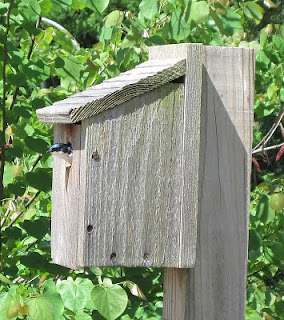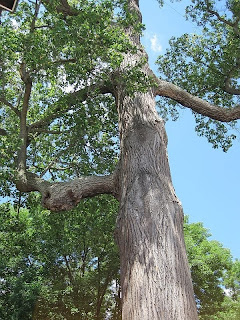This was a nice day to get out with a colleague or two and check our "bluebird" boxes. The current inventory is
- 2 boxes still empty
- 2 boxes with Tree Swallows (6 eggs each)
- 1 box with Chickadees (4 mostly-fledged young)
- 1 box with Carolina Wrens (6 eggs)
 This photo is similar to one I posted a couple weeks ago, but was taken at much closer range. The original is thus much more clear. Once the mother fled the nest, she dive-bombed us until we left. We made quick work of counting the eggs and closing up the box.
This photo is similar to one I posted a couple weeks ago, but was taken at much closer range. The original is thus much more clear. Once the mother fled the nest, she dive-bombed us until we left. We made quick work of counting the eggs and closing up the box.The first time we looked in on the Chickadee, she didn't leave the nest, even after we knocked on the box. When we opened it, she was sitting there and did not leave. We closed up the box and left her alone. She hasn't been there when we checked the chicks. I think I will get a small sheet of Plexiglas so I can slide it up after just cracking open the box's movable wall. Then there is no danger of chicks falling out.
Today, the Wren didn't leave her box until we began to open the box. This is the first time we've seen her. Usually, we can just hear her mate's complex song from a nearby tree. He acts unconcerned while she sasses us: "chip chip".
 Not far from the Wren box we stopped to look at the second-largest Tulip Poplar (Yellow Poplar) tree in Delaware. It is a Specimen tree, and the sign posted nearby states it probably first began growing in 1771. This is based on an estimate, because nobody had cored the tree to count the rings. Its breadth at chest height is more than four feet; the circumference is probably 13-14 feet.
Not far from the Wren box we stopped to look at the second-largest Tulip Poplar (Yellow Poplar) tree in Delaware. It is a Specimen tree, and the sign posted nearby states it probably first began growing in 1771. This is based on an estimate, because nobody had cored the tree to count the rings. Its breadth at chest height is more than four feet; the circumference is probably 13-14 feet.My next-door neighbor has one of these, about half this size. It gets aphids in the Spring, which drop a lot of sugar on any car we park under it. This year so far it seems there have been enough ladybugs to keep the aphids down; lots less sugar.



No comments:
Post a Comment